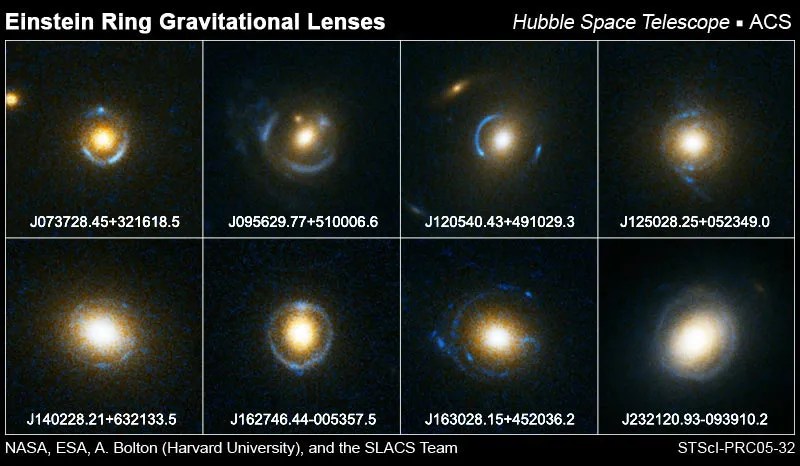3 min read
Astronomers have combined two powerful astronomical assets, the Sloan Digital Sky Survey (SDSS) and NASA's Hubble Space Telescope, to identify 19 new "gravitationally lensed" galaxies. Among these 19, they have found eight new so-called "Einstein rings", which are perhaps the most elegant manifestation of the lensing phenomenon. Only three such rings had previously been seen in visible light.

Image right:
The thin blue bull's-eye patterns in these eight Hubble images appear like neon signs floating over reddish-white blobs. The blobs are giant elliptical galaxies roughly 2 to 4 billion light-years away. The bull's-eye patterns are created as the light from galaxies twice as far away is distorted into circular shapes by the gravity of the giant elliptical galaxies.Image credit: NASA/ESA/SLACS Survey Team
In gravitational lensing, light from distant galaxies is deflected on its way to Earth by the gravitational field of any massive object that lies in the way. Because of this light bending, the galaxy is distorted into an arc or multiple separate images. When both galaxies are exactly lined up, the light forms a bull's-eye pattern, called an Einstein ring, around the foreground galaxy.
Besides producing odd shapes, gravitational lensing gives astronomers the most direct probe of the distribution of dark matter in elliptical galaxies. Dark matter is an invisible and exotic form of matter that has not yet been directly observed. By searching for dark matter in galaxies, astronomers hope to gain insight into galaxy formation, which must have started around lumpy concentrations of dark matter in the early universe.
The newly discovered lenses come from an ongoing project called the Sloan Lens Survey (SLACS). A team of astronomers, led by Adam Bolton of the Harvard-Smithsonian Center for Astrophysics in Cambridge, Mass., and Leon Koopmans of the Kapteyn Astronomical Institute in the Netherlands, selected the candidate lenses from among several hundred thousand optical spectra of elliptical galaxies in the Sloan Digital Sky Survey.
The team was looking for clear evidence of emission from galaxies twice as far from Earth and directly behind the closer galaxies. They used Hubble's Advanced Camera for Surveys to snap images of 28 of these candidate lensing galaxies. By studying the arcs and rings produced by 19 of these candidates, the astronomers precisely measured the mass of the foreground galaxies. These new discoveries add significantly to the approximately 100 gravitational lenses previously known.
"Being able to study these and other gravitational lenses as far back in time as several billion years allows us to see directly whether the distribution of invisible and visible mass changes with cosmic time," says Koopmans. "With this information, we can test the commonly held idea that galaxies form from collision and mergers of smaller galaxies."
The initial findings of the survey will appear in the February 2006 issue of the Astrophysical Journal.
Donna Weaver
Space Telescope Science Institute, Baltimore
Phone: (410) 338-4493







